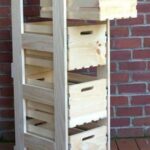Properly maintaining the woodwork around your ceiling attic entrance is essential for both the appearance and functionality of your home. Over time, this area can become worn, damaged or even rotten due to various factors such as humidity, temperature changes, and age.
Neglecting these issues can lead to further deterioration and expensive repairs in the long run. In this article, we will provide you with a step-by-step guide on how to fix woodwork around your ceiling attic entrance, ensuring that it remains not only strong and sturdy but also visually appealing.
The woodwork around your ceiling attic entrance plays a crucial role in maintaining the integrity of your home’s structure. Not only does it provide support and stability for your attic access point, but it also serves as a barrier against drafts, moisture, pests, and other external elements. Additionally, this area is often visible from within your living space, making it an important aesthetic aspect that contributes to the overall beauty of your home.
Identifying common problems with the woodwork around your ceiling attic entrance is the first step towards fixing any issues. Cracks, warping, rotting, mold growth, or even complete deterioration are some of the typical problems that homeowners face in this area. These issues not only compromise the structural integrity but can also pose health risks if left untreated.
In the following sections of this article, we will guide you through assessing damages effectively while providing you with insightful tips on choosing tools and materials specific to fixing woodwork around your ceiling attic entrance. We will also offer easy-to-follow steps on preparing the area before repairing it thoroughly and safely removing any damaged woodwork. Finally, we will delve into selecting suitable replacement materials and how to achieve a flawless finish for long-term durability.
By learning how to fix woodwork around your ceiling attic entrance properly, you are not only preserving its beauty but also maximizing its functionality and ensuring the longevity of your home. Stay tuned, as we walk you through each step with detailed instructions and insightful tips to help you achieve outstanding results.
Common Problems
Cracks and Peeling Paint
One common problem with woodwork around ceiling attic entrances is the presence of cracks and peeling paint. Over time, changes in temperature and humidity levels can cause the wood to expand and contract, leading to cracks in the surface. Additionally, if the area is not properly ventilated, moisture can accumulate, causing the paint to blister and peel off.
To identify this issue, carefully inspect the woodwork for any visible cracks or areas where the paint is peeling. Pay close attention to corners and joints, as these areas are particularly susceptible to damage. Use a flashlight to illuminate dark corners or recesses that may be hidden from view.
Wood Rot
Another common problem found in woodwork around ceiling attic entrances is wood rot. This occurs when moisture infiltrates the wood, providing an ideal environment for fungi to grow and thrive. Signs of wood rot include discolored or soft areas of wood, an earthy smell, and the presence of fungi such as mushrooms or mold.
To assess if there is wood rot present, gently poke the suspicious areas with a screwdriver or other pointed tool. If the tool sinks easily into the wood or leaves behind debris resembling sawdust, it is likely that rot has occurred. Take note of which parts of the woodwork are affected so that they can be properly addressed during repairs.
Insect Infestation
Woodwork around ceiling attic entrances may also experience insect infestations. Common culprits include termites, carpenter ants, and powderpost beetles. Signs of insect infestation include small holes in the wood surface, sawdust-like frass (insect waste), hollow-sounding wood when tapped on with a hard object, and even finding live insects crawling on or near the damaged area.
To determine if there is an insect infestation present, closely examine the woodwork for any signs of damage or activity. Look for exit holes and frass, which are often indications that insects have made a home in the wood. If live insects are observed, it is crucial to consult a professional pest control service to address the infestation before proceeding with repairs.
Identifying these common problems is essential in order to fully understand the extent of the damage and properly address it during repair. By identifying cracks and peeling paint, wood rot, and insect infestations, homeowners can take the necessary steps to restore and maintain their woodwork around ceiling attic entrances.
Assessing the Damage
When it comes to fixing woodwork around the ceiling attic entrance, it is important to assess the damage before proceeding with any repairs. By understanding the extent of the damage and its potential causes, you can ensure that your fix is effective and long-lasting. Here is a step-by-step guide on how to assess the damage:
- Inspect the Woodwork: Start by thoroughly inspecting the woodwork around the ceiling attic entrance. Look for any signs of decay, rot, cracks, or warping. Pay attention to areas where water may have been leaking or pooling, as these are common culprits for damage.
- Determine Potential Causes: Once you have identified any visible damage, try to determine the potential causes behind it. Water damage is often caused by leaks in the roof, plumbing issues, or poor ventilation in the attic. Insect infestations can also lead to wood deterioration. Understanding the underlying causes will help you address them during the repair process.
- Check for Structural Integrity: It is crucial to check if there is any compromise in structural integrity due to the damaged woodwork. If you notice any sagging or instability in the structure, it may require additional reinforcement or support during repairs.
By following these steps and carefully assessing the damage, you will be able to proceed with confidence when fixing woodwork around your ceiling attic entrance.
| Assessment Factors | Potential Causes |
|---|---|
| Decay | Excessive moisture due to leaks or poor ventilation |
| Rot | Water intrusion from damaged roof or plumbing |
| Cracks | Structural stress or age-related deterioration |
| Warping | Changes in humidity or water exposure |
| Sagging or instability | Compromised structural integrity |
Tools and Materials
To successfully fix the woodwork around the ceiling attic entrance, it is important to gather all the necessary tools and materials beforehand. This section will outline the essential items that are needed for this project.
First and foremost, you will need a set of basic hand tools such as a hammer, screwdriver, chisel, and utility knife. These tools will be used during the removal of damaged woodwork and installation of new wood pieces. Additionally, having a pry bar or crowbar can be helpful for removing stubborn nails and trim.
Next, you will require safety equipment including safety goggles and gloves to protect yourself during the repair process. It is crucial to prioritize safety when working with sharp tools and potentially hazardous materials.
In terms of materials, you will need replacement wood boards or trim that matches the existing woodwork. It is important to choose a similar type of wood in order to maintain consistency in appearance. Depending on the extent of the damage, you may also need screws or nails for attaching new pieces of wood.
Furthermore, you may need additional supplies such as wood glue or epoxy resin if there are any cracks or gaps that need to be filled before installing new pieces. Sandpaper or a sanding block may also be required for smoothing out rough edges and ensuring a seamless finish.
Lastly, it is advisable to have a tape measure and level on hand for accurate measurements and alignment during installation.
By having these tools and materials ready before starting your repair project, you will be well-prepared to fix any issues with the woodwork around your ceiling attic entrance.
Step 1
Before you begin repairing the woodwork around your ceiling attic entrance, it is crucial to properly prepare the area. This step is essential to ensure a smooth and successful repair process. Here are some detailed instructions on how to prepare the area before starting the repairs.
- Clear the Area: Start by removing any furniture, decorations, or items that may obstruct your work area. Clearing the space will provide you with ample room to maneuver and complete the repairs efficiently.
- Protect Surrounding Surfaces: Cover surrounding surfaces such as walls, floors, and any exposed insulation with drop cloths or plastic sheets. This will protect them from dust, debris, and potential damage during the repair process.
- Wear Protective Gear: Before you start any repairs, make sure to wear appropriate protective gear such as safety glasses, gloves, and a dust mask. Repairing woodwork can create sawdust and other particles that can be harmful if inhaled or come into contact with your skin.
- Gather Tools and Materials: Ensure that you have all the necessary tools and materials mentioned earlier in the article outline. This includes a hammer, chisel, pry bar, nails or screws for attaching new woodwork pieces, sandpaper for smoothing out rough surfaces, a tape measure for accurate measurements, and paint or stain for finishing touches.
By following these detailed preparation instructions, you can create an optimal work environment for repairing the woodwork around your ceiling attic entrance. Taking this time to adequately prepare will help ensure that your repairs are efficient, effective, and minimize any potential damage or problems during the process.
Step 2
When it comes to fixing woodwork around the ceiling attic entrance, removing the damaged pieces is an essential step. However, it is crucial to do this task carefully and skillfully to avoid causing any further harm. Here are some techniques that will help you safely remove the damaged woodwork without compromising the surrounding area:
- Assess the damage: Before you start removing any wood, thoroughly inspect the extent of the damage. This will give you a better idea of what type of repair work needs to be done and how much material needs to be removed.
- Gather necessary tools: To remove damaged wood safely, you will need a set of tools including a pry bar, chisel, reciprocating saw, and a hammer. These tools will help you in different aspects of the removal process.
- Create an entry point: If there are nails or screws holding the damaged wood in place, use a nail punch or screw extractor to loosen them and create an entry point for removal.
- Start with gentle prying: Begin by using a pry bar or chisel to gently separate the damaged wood from its adjacent parts. Apply even pressure and work your way around until you can easily lift off the piece.
- Cut if necessary: If parts of the damaged wood are difficult to remove with prying alone, employ a reciprocating saw to make controlled cuts. Take caution not to cut into surrounding structure or wiring.
- Remove any fasteners: Once all pieces of damaged wood have been removed, check for any remaining nails or screws in the area. Remove these using pliers or a hammer and dispose of them safely.
By following these techniques, you can safely remove the damaged woodwork around your ceiling attic entrance without causing further harm. Remember to take your time and work carefully to minimize any potential damage to the surrounding area. Once the damaged wood has been successfully removed, you can proceed to the next step of installing new woodwork.
Next Section: Step 3: Installing New Woodwork: A comprehensive guide on choosing the right type of wood and installing it properly
Step 3
Step 3: Installing New Woodwork: A Comprehensive Guide on Choosing the Right Type of Wood and Installing it Properly
Once you have safely removed the damaged woodwork around your ceiling attic entrance, it’s time to install new woodwork. This step is crucial for not only restoring the functionality of your attic entrance but also enhancing its visual appeal. In this section, we will provide you with a comprehensive guide on choosing the right type of wood and installing it properly.
Choosing the Right Type of Wood
When selecting wood for your new attic entrance woodwork, it’s important to consider both its durability and aesthetic appeal. Here are some popular options:
- Hardwood: Hardwoods like oak, cherry, or walnut are known for their strength and durability. They can withstand frequent use and resist wear and tear effectively.
- Softwood: Softwoods such as pine or cedar are less expensive options that still offer decent durability. They are easier to work with due to their softer nature.
- Engineered Wood: Engineered wood products like Medium Density Fiberboard (MDF) or plywood can be an affordable alternative to solid wood. They are composed of real wood fibers or veneers that are bonded together using adhesives.
Consider factors such as cost, maintenance requirements, and the overall style of your home when choosing the right type of wood for your ceiling attic entrance.
Installing New Woodwork Properly
- Measure Twice: Take accurate measurements of the area where the new woodwork will be installed. Double-check these measurements to ensure a precise fit.
- Cut the Wood: Use a saw or other cutting tools to carefully cut each piece of wood according to your measurements. Remember to wear safety goggles and gloves during this process.
- Secure the Wood: Start by attaching supports or braces behind the area where you will install the new woodwork. This will provide additional stability. Then, use screws or nails to fasten the wood securely in place.
- Finishing Touches: Sand any rough edges and apply a primer or sealant to protect the wood from moisture and damage. Finish with a coat of paint or stain for an aesthetically pleasing look that matches your existing decor.
Remember to follow all manufacturer’s instructions when working with wood products and make sure to allow proper drying time before using the attic entrance again.
By following these guidelines, you can ensure that your new woodwork is installed properly, guaranteeing its longevity and enhancing the overall functionality and appearance of your ceiling attic entrance.
Step 4
Once you have successfully installed the new woodwork around your ceiling attic entrance, it’s time to focus on the finishing touches. This step is essential as it not only ensures a seamless finish but also enhances the overall appearance of the woodwork. Here are some tips and tricks to help you achieve professional-looking results:
- Sanding: Start by sanding the newly installed woodwork using fine-grit sandpaper. This will smooth out any rough edges or imperfections, creating a seamless surface. Make sure to sand in the direction of the grain for best results.
- Staining or Painting: Depending on your preference, you can choose to stain or paint the woodwork. If you opt for staining, select a color that matches the existing wood tones in your home. Before applying any stain or paint, make sure to thoroughly clean the surface and remove any dust or debris.
- Applying Protective Coating: Protect your newly finished woodwork by applying a clear protective coating such as polyurethane or varnish. This will help prevent scratches, stains, and other damage caused by everyday wear and tear.
- Adding Decorative Details: Consider adding decorative details such as crown molding or trim to further enhance the appearance of your woodwork. These small touches can make a big difference in giving your ceiling attic entrance a polished look.
- Regular Maintenance: To prolong the lifespan of your woodwork and keep it looking its best, regular maintenance is important. This includes routine cleaning with a gentle cleaner and periodic reapplication of protective coatings if needed.
By following these tips and tricks for finishing touches, you can ensure that your woodwork not only serves its functional purpose but also adds beauty and charm to your home’s interior. Take pride in your craftsmanship, as well-maintained woodwork can greatly contribute to the overall aesthetic appeal of your ceiling attic entrance.
Preventive Maintenance
After successfully repairing and restoring the woodwork around your ceiling attic entrance, it’s important to implement preventive measures to ensure its longevity. By taking proactive steps, you can avoid costly repairs and maintain the integrity of the woodwork for years to come. Here are some expert advice on how to prevent future damage:
- Regular inspections: Make it a habit to inspect the woodwork around your ceiling attic entrance at least once or twice a year. Look for signs of wear and tear, such as cracks, peeling paint, or water damage. By catching these issues early on, you can address them quickly before they worsen.
- Maintain proper ventilation: Proper ventilation is crucial in preventing moisture buildup, which can lead to wood rot and other forms of damage. Ensure that your attic has adequate vents or fans installed to promote air circulation. Additionally, you should check for any obstructions that may block airflow.
- Keep humidity levels in check: High humidity levels can cause wooden structures to swell, warp, or even develop mold and mildew growth. Use a hygrometer to monitor the humidity levels in your attic space and take appropriate steps to regulate it if necessary. This may include using dehumidifiers or implementing moisture-absorbing materials like silica gel packs.
- Seal gaps and cracks: Inspect the area around the woodwork regularly for any gaps or cracks that could allow pests or moisture into your home. Use caulk or weatherstripping to seal these gaps effectively and prevent further damage.
- Apply protective finishes: To enhance the durability of your woodwork, consider applying protective finishes such as varnish or paint specifically formulated for outdoor use. These finishes provide an additional layer of protection against UV rays, moisture, and other elements.
By following these preventive maintenance tips, you can extend the life of the woodwork around your ceiling attic entrance and minimize the need for future repairs. Remember that regular inspections and proactive measures are key to maintaining its condition and preserving the overall appearance of your home.
Conclusion
In conclusion, maintaining the woodwork around the ceiling attic entrance is essential for both functionality and aesthetics. By following the steps outlined in this article, you can effectively address common problems such as rot, mold, and deterioration.
Firstly, it is crucial to assess the damage accurately to determine the extent of the repairs needed. Identifying the causes of the damage will help prevent future issues. Once you have gathered your tools and materials, preparing the area before starting repairs is essential to ensure a smooth process.
Removing damaged woodwork should be done with caution to avoid causing further harm. Carefully selecting the right type of wood and installing it properly are crucial steps in restoring your ceiling attic entrance’s appearance and functionality. Finish with attention to detail to achieve a seamless result that enhances your overall space.
To prevent future damage, regular maintenance is key. Inspect your woodwork periodically for any signs of wear or potential issues that need prompt attention. Implementing preventive measures such as sealing joints and applying protective finishes will help extend its longevity.
Frequently Asked Questions
How do you seal an attic door in the ceiling?
To seal an attic door in the ceiling, you can start by inspecting the door for any gaps or cracks that might be allowing air to escape or enter. Apply weatherstripping around the edges of the door to create a tight seal when closed. If there are larger gaps, use expanding foam insulation to fill them in and ensure a secure barrier against air leakage.
Additionally, consider adding insulation on top of the attic door, such as a blanket or panel, to further enhance its energy efficiency. By properly sealing your attic door, you can prevent heat loss and maintain a more comfortable temperature within your home.
How do I fix a gap in my attic door?
Fixing a gap in your attic door typically involves identifying the cause of the gap and choosing an appropriate solution accordingly. If it’s a small gap, you can use weatherstripping adhesive or caulking to fill it in and create a seamless seal. For larger gaps, consider using wood putty or epoxy filler to bridge the space and provide a sturdy fix.
It’s important to ensure that any repairs made are strong enough to withstand regular usage of the attic door without compromising its integrity. Properly fixing gaps in your attic door will not only prevent drafts but also help maintain consistent temperatures throughout your home.
How do you cut and frame an attic access?
Cutting and framing an attic access requires careful planning and consideration of specific measurements. First, determine where you want your access point located within the ceiling of your desired room or hallway area leading up to the attic space.
The size of the opening will depend on factors such as building codes and regulations as well as personal preference. Once you’ve determined these dimensions, mark out the area on both sides of the ceiling using a measuring tape and chalk line for accuracy.

Hi everyone! I’m a woodworker and blogger, and this is my woodworking blog. In my blog, I share tips and tricks for woodworkers of all skill levels, as well as project ideas that you can try yourself.





